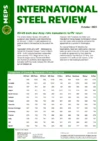Czech steel contract buyers secure H2 price reductions
Central Europe's flat steel producers were forced to make price concessions during recent contractual negotiations, with Czech buyers, for the second half of 2024.
The consensus view of Czech respondents is that discounts of EUR30-50 per tonne were secured, for both quarterly and half-yearly agreements, compared with contracts negotiated in the first six months of the year.
- This article draws on research conducted for the July edition of MEPS’s International Steel Review. The monthly publication features commentaries, prices, indices and forecasts covering key steel markets in North America, Asia and Europe. Contact MEPS for details of how to subscribe.
In opening discussions, regional producers of cold rolled coil and galvanised products initially proposed a price rollover for the second half of 2024. They cited increased costs from energy, transport and labour in their efforts to maintain their prices and protect profit margins.
Nevertheless, Czech buyers – buoyed by mills’ reluctance to propose higher values in the early exchanges – felt that they would be able to force producers to lower their prices.
Contract buyers’ confidence in achieving discounts was also underpinned by a significant gap between contract and spot values. Mills’ attempts to lift their monthly prices had largely fallen on deaf ears, prompting a decline in spot prices during May and June. Their pricing discipline subsequently faltered and reduced prices were offered.
Reasons for contract price concessions
There were a number of reasons that such price concessions were made.
Purchasing managers, in Czechia, report that buying activity is low at service centre and end-user level. Stockists can buy flexibly and at short notice. Most Czech consumers are also keeping their procurement at a minimum ahead of the summer holidays.
End-user activity remains subdued. Demand from the country’s automotive sector is mixed as carmakers switch their focus back to hybrid vehicles, at the expense of electric cars. This is because of cost implications, the lack of infrastructure in many European countries, and the growing threat of low-cost competition from China.
The white and yellow goods industries also remain subdued. Activity levels in the electrical and welding segments have slowed, with demand for HVAC (heating, ventilation and air-conditioning) considerably down.
Construction-related activity, notably for residential purposes, continues to be negatively influenced by the relatively high cost of finance, which is deterring new house builds.
Many Czech market respondents readily admit that the domestic steel industry is hugely exposed to developments elsewhere. Export sales to larger neighbours, such as Germany and Poland, remain low. In turn, German and Polish service centres – faced with weak domestic demand – have become increasingly active in Czechia as they aim to sell surplus stock.
Mills’ mitigation of price decline
In light of the considerable downward price pressure resulting from this shortfall in demand, mills held their price discipline on steel buyers’ three and six-month contract agreements more effectively than anticipated. Some Czech consumers of cold rolled and hot dipped galvanised coil told MEPS that they had expected bigger discounts than those eventually agreed.
A handful of factors contributed to producers’ ability to mitigate the extent of the price erosion.
Central Europe’s supply of strip products is limited, relative to that in other parts of the continent. This is largely attributed to continued production problems at Liberty Steel Group’s operations at Dunaferr (Hungary) and Galati (Romania).
Delivery lead times for flat products are extending, albeit as a consequence of outages for planned mill maintenance. Key steel producers are scaling down their capabilities during the summer months. Some galvanising and pickling lines will be out of operation.
The capacity cuts will have a negligible effect while steel consumption remains low.
However, Czech steel buyers may be encouraged by signs that the domestic economy is showing signs of recovery. Inflation, which had reached 17.5% in January 2023, declined to 2% in June of this year.
Czechia’s Central Bank, the Ceska Narodni Banka, has cut its key interest rate throughout the first half of 2024. The most recent cut was by half a percentage point, to 4.75%, in late June.
Nevertheless, little demand improvement is expected in the Czech steel market for the remainder of the year. Most Central European participants report that there is little potential for a significant recovery until 2025 at the earliest. This is because political and economic uncertainties are likely to persist as war continues in nearby Ukraine.

Source:
International Steel Review
The MEPS International Steel Review is an essential monthly publication, offering professional analysis and insight into carbon steel prices around the world.
Go to productRequest a free publication





